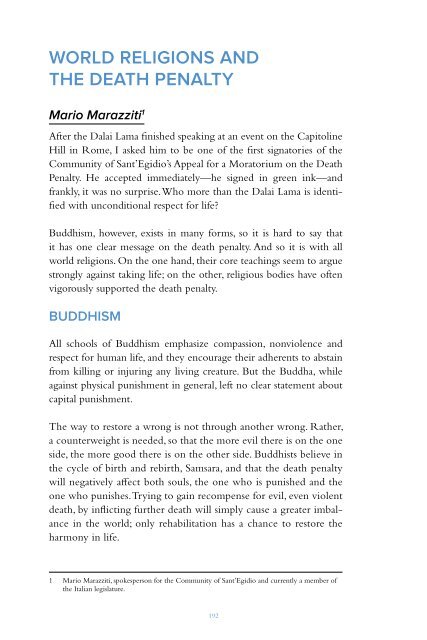PENALTY
DBk0302s7Xm
DBk0302s7Xm
Create successful ePaper yourself
Turn your PDF publications into a flip-book with our unique Google optimized e-Paper software.
WORLD RELIGIONS AND<br />
THE DEATH <strong>PENALTY</strong><br />
Mario Marazziti 1<br />
After the Dalai Lama finished speaking at an event on the Capitoline<br />
Hill in Rome, I asked him to be one of the first signatories of the<br />
Community of Sant’Egidio’s Appeal for a Moratorium on the Death<br />
Penalty. He accepted immediately—he signed in green ink—and<br />
frankly, it was no surprise. Who more than the Dalai Lama is identified<br />
with unconditional respect for life?<br />
Buddhism, however, exists in many forms, so it is hard to say that<br />
it has one clear message on the death penalty. And so it is with all<br />
world religions. On the one hand, their core teachings seem to argue<br />
strongly against taking life; on the other, religious bodies have often<br />
vigorously supported the death penalty.<br />
BUDDHISM<br />
All schools of Buddhism emphasize compassion, nonviolence and<br />
respect for human life, and they encourage their adherents to abstain<br />
from killing or injuring any living creature. But the Buddha, while<br />
against physical punishment in general, left no clear statement about<br />
capital punishment.<br />
The way to restore a wrong is not through another wrong. Rather,<br />
a counterweight is needed, so that the more evil there is on the one<br />
side, the more good there is on the other side. Buddhists believe in<br />
the cycle of birth and rebirth, Samsara, and that the death penalty<br />
will negatively affect both souls, the one who is punished and the<br />
one who punishes. Trying to gain recompense for evil, even violent<br />
death, by inflicting further death will simply cause a greater imbalance<br />
in the world; only rehabilitation has a chance to restore the<br />
harmony in life.<br />
The cruel ultimate punishment has little chance of healing society<br />
and re-establishing the law, because excessive cruelty injures the mind<br />
of the offender and of those who administer death, whatever the<br />
reason. Compassion cannot cope with capital punishment; if a crime<br />
is horrible, as a last resort, the offender should be banished from the<br />
community so as not to do any further harm.<br />
But in many countries where Buddhism is influential, such as Myanmar<br />
and Thailand, the death penalty is still legal and executions are<br />
still carried out; the practical needs of the society have prevailed. It<br />
seems that capital punishment and Buddhism are on two opposite<br />
sides philosophically but not historically.<br />
Buddhist doctrines hold nonviolence and compassion for all<br />
life in high regard. The First Precept of Buddhism requires<br />
individuals to abstain from injuring or killing all living<br />
creatures and Buddha’s teaching restricts Buddhist monks<br />
from any political involvement. Using historical documents<br />
and interviews with contemporary authorities on Buddhist<br />
doctrine, our research uncovered a long history of political<br />
involvement by Buddhist monks and Buddhist support of<br />
violence. Yet, there seems to be limited Buddhist involvement<br />
in Southeast Asian countries in death penalty issues.<br />
. . .<br />
The death penalty is inconsistent with Buddhist teachings.<br />
. . . Yet, evidence suggests that most Southeast Asian countries<br />
practiced capital punishment long before the Buddhist<br />
influence emerged in India in 400 to 500 B.C. 2<br />
Tomoko Sasaki, a former member of the Japanese parliament, evoked<br />
retribution: “A basic teaching [in Japanese Buddhism] is retribution.<br />
If someone evil does something bad, he has to atone with his own life.<br />
If you take a life, you have to give your own.” 3 The concept of retribution<br />
could be seen as consistent with the central concept of karma<br />
in Buddhism, the way in which the Buddha explained inequality and<br />
1 Mario Marazziti, spokesperson for the Community of Sant’Egidio and currently a member of<br />
the Italian legislature.<br />
2 Leanne Fiftal Alarid and Hsiao-Ming Wang, “Mercy and punishment: Buddhism and the death<br />
penalty”, Social Justice, vol. 28 (2001), pp. 231-247.<br />
3 Charles Lane, “Why Japan still has the death penalty”, Washington Post, 16 January 2005.<br />
192 193


